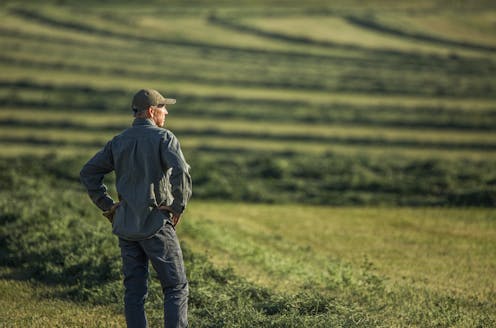America's farmers are getting older, and young people aren't rushing to join them
It’s part of a decadeslong trend.


On Oct. 12, National Farmers’ Day, Americans honor the hardworking people who keep the world fed and clothed.
But the farming labor force has a problem: It’s aging rapidly.
The average American farmer is 57 and a half years old, according to the most recent data from the U.S. Department of Agriculture. That’s up sharply from 1978, when the figure was just a smidge over 50.
As researchers who study well-being in rural areas, we wanted to understand this trend and its implications. So we dug into the data.
Amber waves of graying
We found that the average age of farmers was fairly consistent across the country, even though the general population’s age varies quite a bit from place to place.
For example, the average Maine farmer is just a few months older than the average farmer in Utah, even though the average Maine resident is more than a decade older than the average Utahn.
To be fair, we did find some local differences. For example, in New York County – better known as Manhattan – the average farmer is just north of 31. Next door in Hudson County, New Jersey, the average farmer is more than 72.
On the whole, though, America’s farming workforce is getting older. If the country doesn’t recruit new farmers or adapt to having fewer, older ones, it could put the nation’s food supply at risk. Before panicking, though, it’s worth asking: Why is this happening?
A tough field to break into
To start, there are real barriers to entry for young people – at least those who weren’t born into multigenerational farming families. It takes money to buy the land, equipment and other stuff you need to run a farm, and younger people have less wealth than older ones.
Young people born into family farms may have fewer opportunities to take them over due to consolidation in agriculture. And those who do have the chance may not seize it, since they often report that rural life is more challenging than living in a city or suburb.
The overall stress of the agriculture industry is also a concern: Farmers are often at the mercy of weather, supply shortages, volatile markets and other factors entirely out of their control.
In addition to understanding why fewer younger people want to go into agriculture, it’s important to consider aging farmers’ needs. Without younger people to leave the work to, farmers are left with intense labor — physically and mentally – to accomplish, on top of the ordinary challenges of aging.
In other words, the U.S. needs to increase opportunities for younger farmers while also supporting farmers as they age.
Opportunities to help
The USDA already has programs to aid new farmers, as well as farmers of color and female farmers, and those who operate small farms. Expanding these programs’ reach and impact could help bring new talent into the field.
Congress could do just that when it reauthorizes the farm bill – a package of laws covering a wide range of food – and agriculture-related programs that get passed roughly every five years.
The farm bill also includes nutrition aid and funds telehealth and training and educational outreach for farmers, all of which could help meet the needs of young and aging farmers alike. Notably, the Cooperative Extension Service offers programs that range from 4-H and youth development, including introduction to agriculture, to providing on-site technical help.
Congress was supposed to reauthorize the farm bill by Sept. 30, 2023, but it missed that deadline. It now faces a new deadline of Dec. 31, but due to dysfunction in the House of Representatives, many expect the process to drag on into 2024.
Also in 2024, the USDA will release its next Census of Agriculture, giving researchers new insight into America’s farming workforce. We expect it will show that the average age of U.S. farmers has reached a new all-time high.
If you believe otherwise – well, we wouldn’t bet the farm.
David R. Buys receives funding from the Centers for Disease Control and Prevention, the United States Department of Agriculture National Institute of Food and Agriculture (NIFA), the Substance Abuse and Mental Health Services Administration, the Health Resources and Services Administration, and the National Institutes of Health.
As Director of the Southern Rural Development Center, one of the nation's four Regional Rural Development Centers (RRDCs) focused on enhancing capacity in research and Extension among Land-Grant Universities, John J. Green is involved in projects funded through the U.S. Department of Agriculture's National Institute of Food and Agriculture. Relevant to this topic are base funding support for RRDCs and the Agricultural and Food Research Initiative Competitive Program grant 2021-67023-34425 and his participation in the Rural Population Research Network (W5001). He also receives support as part of the Interdisciplinary Network on Rural Population Health and Aging funded by the National Institute on Aging grant R24-AG065159. The opinions expressed here are those of the authors and do not necessarily reflect the views of these funders.
As an Assistant Professor of Human Development and Family Science at Mississippi State University, Mary Nelson Robertson is involved in projects supported by United States Department of Agriculture (USDA) National Institute of Food and Agriculture (NIFA) Rural Health and Safety Education Grant No. 2020-46100-32841, Department of Health and Human Services Substance Abuse and Mental Health Services Administration Rural Opioids Technical Assistance (ROTA) Grant No. 5H79TI083275-02, and USDA NIFA Farm and Ranch Stress Assistance Network (FRSAN): Southern Region Grant No. 2020-70028-32730 from the University of Tennessee Extension Service, and USDA NIFA FRSAN: State Department of Agriculture Grant No. 2021-70035-35566 from Mississippi Department of Agriculture and Commerce.
Read These Next
How the ‘slayer rule’ might play a role in determining who will inherit wealth from Rob Reiner and h
These rules have a long history in the United States. They played a role in the notorious murders by…
The celibate, dancing Shakers were once seen as a threat to society – 250 years later, they’re part
‘The Testament of Ann Lee,’ Mona Fastvold’s 2025 film, depicts part of the long history of Shaker…
From truce in the trenches to cocktails at the consulate: How Christmas diplomacy seeks to exploit s
World leaders like to talk up peace at Christmastime. But alongside the tales of seasonal breaks in…






